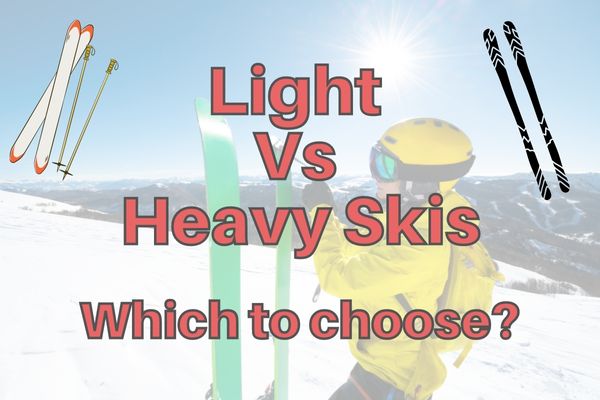The weight of skis can be an important factor, especially when you’re first learning to ski. Lightweight skis can feel easier to control and controllable while heavier ones can be more stable.
When you choose lightweight skis, you often run the risk of losing some performance in terms of stability and smoothness in your skiing compared to heavy skies, but for a lighter person that might be a good trade-off.
The key points to help you choose the ideal weight for your skis are:
- Lighter skis are less tiring, more maneuverable, and lend themselves to experienced skiers.
- Ideal users of lighter skis are those who have something to compare them to (i.e. they really feel their heavy skis are too heavy), those who want to tour uphill, and everyone else who feels restricted by heavier skis.
- When you choose lightweight skis, you often run the risk of losing some performance especially at high speeds.
- The better snow quality, the lighter your skis can be without feeling the compromise between freedom and stability. E.g. light skis are not good for very icy slopes but fine if a well prepared layer of new snow is present.
- But remember, ski weight is relative to the skier’s build and skier type, so the best weight for your skis will depend on your weight!
However, the right choice will always depend on your skill level and the type of skiing you like to do.
Does the weight of the skis matter?
The weight of your skis is not the only factor that affects your skiing, but it certainly does matter!
A difference of just a few grams can make all the difference. Generally, the lighter your skis are, the easier they will be to maneuver. However, the lighter your skis are, the less efficient they will be at maintaining contact with the snow and enduring repeated flexing.
Ski construction has evolved from the early solid hickory skis to the modern composite layers.
In the old days, various kinds of wood are used for the core of the ski. Wood is an excellent material for the core because of its springiness, durability, and ability to dampen vibrations.
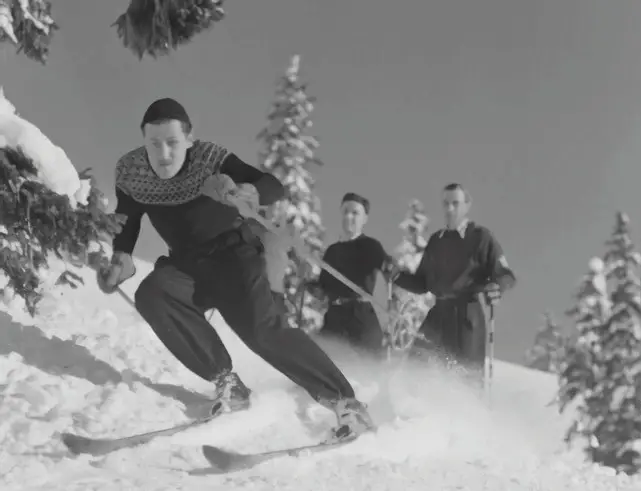
Today, The ski industry is increasingly favoring lighter-weight skis than in the past, using materials like carbon, graphene, lightweight balsa wood, foam, and paulownia to reduce weight.
Skis are generally categorized as “light,” “heavy,” or somewhere in between based on their weight per pair:
- Less than 3,000 g/pair = Featherweights (typically used for alpine touring)
- 3,000-3,500 g/pair = Lightweights (resort and backcountry options)
- 3,500-4,000 g/pair = Middleweights (prefer resort skiing)
- More than 4,000 g/pair = Heavyweights (aim to provide best resort performance)
The most common types of skis used by recreational skiers are in the heavy category and typically between 4500 to 6800 grams or 10 to 15 pounds.
Are lighter skis better for beginners?
People love lightweight skis for a few reasons: they’re less tiring to ski on, more maneuverable, and lend themselves well to adventures
There is a trade-off between weight and performance. Lightweight skis will be easier to maneuver but will cling less well to the snow, so you may lose performance when going too light and fast!
While it can feel like there aren’t as many lightweight options for beginner and intermediate skiers these days, that hasn’t always been the case. In fact, lightweight skis used to be much more common for beginners.
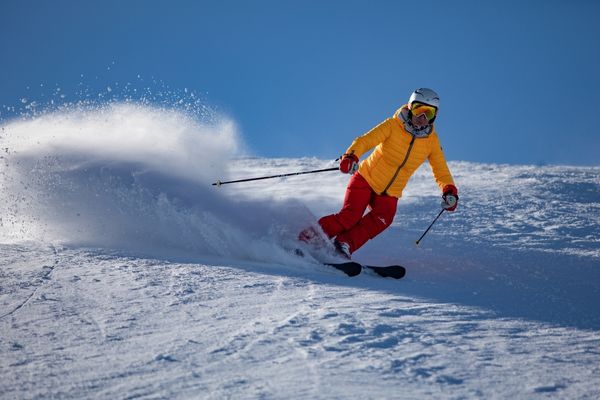
Thankfully, those days seem to have passed. Thanks to improvements in ski materials and design, participating in downhill skiing doesn’t nearly require superhuman strength or fortitude. As our ski industry evolves, we have access to more lightweight options—and more options for skis at every weight.
If you often find yourself in a never-ending battle with your gear, lightweight skis can be a game changer. Those carbon skis might cost a grip more than wood, but if they improve your daily experience and ability to ski more days each season, they’re worth the investment.
Heavy skis will be tiring to ski, and light, dainty, skis can be bucked by cut-up snow and vibrate during high speeds. However, if you plan to ski for a long time, a lighter pair will keep you from getting tired.
The length of skis is important because it affects the turn radius. Shorter skis have a sharper turn, but at the expense of top-end speed and flotation. Beginners should also consider the length of the skis before deciding on a pair.
Are lighter skis easier to control?
Skis come in a variety of weights and sizes, and the weight you carry can make them easier or more difficult to control.
Lighter weights are typically easier to control because they are easier to turn and maneuver, but a heavier pair may be easier to balance and maneuver at low to moderate speeds. However, at high speeds, lighter skis will be more insecure and subject to vibrations, less grip, and low control.
The length of the ski is also important for maneuverability and stability. Longer skis have more edge contact with the snow, and they are more stable at high speeds. Longer skis also have a longer turning radius, which makes them easier to control at high speeds.
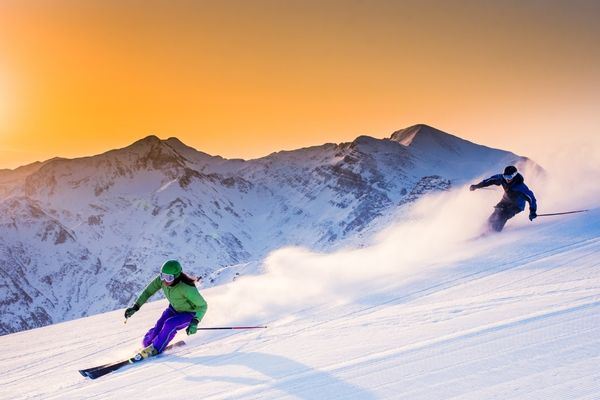
Lighter skis are easier to control and maneuver, but they also lack a lot of stability. Shorter skis are also easier to control than long skis and offer less resistance when you push through turns.
Shorter skis also have shorter edges, so they won’t grip ice and won’t be as stable at high speeds. They can also put greater force on the knee and ankle joints. These forces can cause injury, especially if you make sharp turns at high speeds.
But remember, that other equipment is also important for your safety at high speeds such as the right types of skiing goggles, a good skiing jacket and proper waxing of your skis.
Are heavier skis more stable?
A heavy ski is not necessarily a better choice for stability, but they will usually be better for hig speed, harder snow and icy conditions.
A lightweight ski can be too unstable when the conditions change. The more stable the ski, the more powerful it will be.
But this advantage comes at a cost. A heavy ski can push through more snow than a lightweight one, so you should keep this in mind before making your choice.
But the weight of an optimal set of skis depends on the weight of the skier and the types of skis.
Longer skis have a greater surface area and mass, and are more stable when skiing hard snow where the contact area needs to be bigger for stability. They are more stable at high speeds and are therefore better for big jump landings or half pipes.
On groomed snow, stiffer skis carve more easily and are better for a variety of conditions.
Are lighter skis safer?
Not really, but it depends on your weight and strength.
Just as with a light ski, a heavy ski does not automatically make the ski safer, although it does make it harder to make quick maneuvering that can be dangerous to perform. So in a sense, yes, the heavy skis are safer for most beginners at least.
You ski safer when you don’t get injured, not when you are injured. Or at least, that’s what we believe.
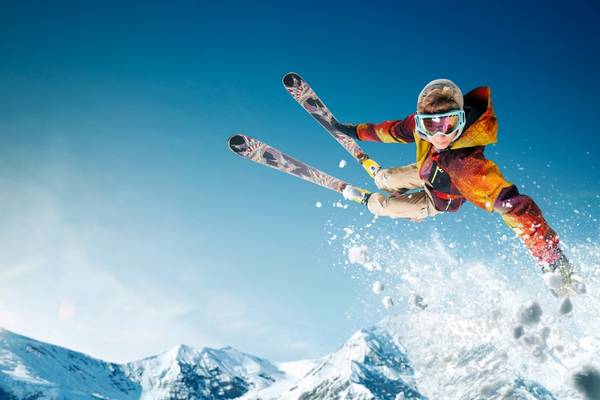
A ski’s weight can affect your injury risk, though. Skis, like our bodies, are stronger in certain places than others. The strongest areas are not necessarily the areas covered by our boots and bindings. Those areas are governed by physics.
And the laws of physics tell us that heavier skis have more mass to absorb force when those skis get whacked. In other words, when you accidentally run into someone on the chairlift, the more likely it is that the heavy ski will absorb that impact.
Conclusion: are lighter or heavier skis better?
If you are in the market for new skis, you are probably wondering if it’s better to go with heavier ones or lighter ones.
You’ll find that light ones are generally tippier and more affected by high speeds and the hardness of the snow. This can be an advantage for an experienced skier, but not always for a beginner as they are very hard to control! Another downside of light skis is that they cost more than heavier ones.
So if you want to go faster, or you are new to skiing you should choose a heavier ski. The heavier one is much stiffer and will be more stable in moguls.
There are many factors that determine ski weight. It really comes down to the style and purpose of skiing. Also, consider the material of the ski as some are stiffer and some will bend more easily like carbon fiber although it does not break easily.

